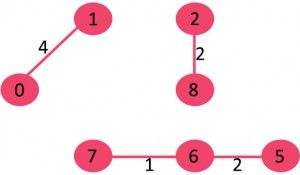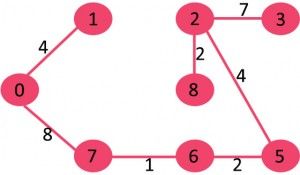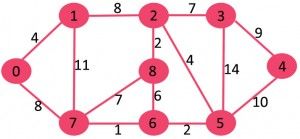贪心算法(2)-Kruskal最小生成树
原文地址 http://www.acmerblog.com/greedy-kruskal-spanning-tree-mst-5326.html
什么是最小生成树?
生成树是相对图来说的,一个图的生成树是一个树并把图的所有顶点连接在一起。一个图可以有许多不同的生成树。一个有 n 个结点的连通图的生成树是原图的极小连通子图,且包含原图中的所有 n 个结点,并且有保持图连通的最少的边。最小生成树其实是最小权重生成树的简称。生成树的权重是考虑到了生成树的每条边的权重的总和。
最小生成树有几条边?
最小生成树有(V – 1)条边,其中V是给定的图的顶点数量。
Kruskal算法
下面是步骤寻找MST使用Kruskal算法
1 |
1,按照所有边的权重排序(从小到大) |
2 |
3 |
2,选择最小的边。检查它是否形成与当前生成树形成环。如果没有形成环,讲这条边加入生成树。否则,丢弃它。 |
4 |
5 |
3,重复第2步,直到有生成树(V-1)条边 |
步骤2使用并查集算法来检测环。如果不熟悉并查集建议阅读下并查集。
该算法是一种贪心算法。贪心的选择是选择最小的权重的边,并不会和当前的生成树形成环。让我们了解一个例子,考虑下面输入图
该图包含9个顶点和14个边。因此,形成最小生成树将有(9 – 1)= 8条边。
01 |
排序后: |
02 |
Weight Src Dest |
03 |
1 7 6 |
04 |
2 8 2 |
05 |
2 6 5 |
06 |
4 0 1 |
07 |
4 2 5 |
08 |
6 8 6 |
09 |
7 2 3 |
10 |
7 7 8 |
11 |
8 0 7 |
12 |
8 1 2 |
13 |
9 3 4 |
14 |
10 5 4 |
15 |
11 1 7 |
16 |
14 3 5 |
现在从已经排序的边中逐个选择
1. Pick edge 7-6: No cycle is formed, include it.

2. Pick edge 8-2: No cycle is formed, include it.
3. Pick edge 6-5: No cycle is formed, include it.
4. Pick edge 0-1: No cycle is formed, include it.

5. Pick edge 2-5: No cycle is formed, include it.
6. Pick edge 8-6: Since including this edge results in cycle, discard it.
7. Pick edge 2-3: No cycle is formed, include it.
8. Pick edge 7-8: Since including this edge results in cycle, discard it.
9. Pick edge 0-7: No cycle is formed, include it.

10. Pick edge 1-2: Since including this edge results in cycle, discard it.
11. Pick edge 3-4: No cycle is formed, include it.
目前为止一家有了 V-1 条边,可以肯定V个顶点都一包含在内,到此结束。
代码实现:
001 |
// Kruskal 最小生成树算法 |
002 |
#include <stdio.h> |
003 |
#include <stdlib.h> |
004 |
#include <string.h> |
005 |
006 |
// 带有权重的边 |
007 |
struct Edge |
008 |
{ |
009 |
int src, dest, weight; |
010 |
}; |
011 |
012 |
// 无向图 |
013 |
struct Graph |
014 |
{ |
015 |
// V-> 顶点个数, E->边的个数 |
016 |
int V, E; |
017 |
// 由于是无向图,从 src 到 dest的边,同时也是 dest到src的边,按一条边计算 |
018 |
struct Edge* edge; |
019 |
}; |
020 |
021 |
//构建一个V个顶点 E条边的图 |
022 |
struct Graph* createGraph(int V, int E) |
023 |
{ |
024 |
struct Graph* graph = (struct Graph*) malloc( sizeof(struct Graph) ); |
025 |
graph->V = V; |
026 |
graph->E = E; |
027 |
graph->edge = (struct Edge*) malloc( graph->E * sizeof( struct Edge ) ); |
028 |
return graph; |
029 |
} |
030 |
031 |
//并查集的结构体 |
032 |
struct subset |
033 |
{ |
034 |
int parent; |
035 |
int rank; |
036 |
}; |
037 |
038 |
// 使用路径压缩查找元素i |
039 |
int find(struct subset subsets[], int i) |
040 |
{ |
041 |
if (subsets[i].parent != i) |
042 |
subsets[i].parent = find(subsets, subsets[i].parent); |
043 |
044 |
return subsets[i].parent; |
045 |
} |
046 |
047 |
// 按秩合并 x,y |
048 |
void Union(struct subset subsets[], int x, int y) |
049 |
{ |
050 |
int xroot = find(subsets, x); |
051 |
int yroot = find(subsets, y); |
052 |
if (subsets[xroot].rank < subsets[yroot].rank) |
053 |
subsets[xroot].parent = yroot; |
054 |
else if (subsets[xroot].rank > subsets[yroot].rank) |
055 |
subsets[yroot].parent = xroot; |
056 |
else |
057 |
{ |
058 |
subsets[yroot].parent = xroot; |
059 |
subsets[xroot].rank++; |
060 |
} |
061 |
} |
062 |
063 |
// 很据权重比较两条边 |
064 |
int myComp(const void* a, const void* b) |
065 |
{ |
066 |
struct Edge* a1 = (struct Edge*)a; |
067 |
struct Edge* b1 = (struct Edge*)b; |
068 |
return a1->weight > b1->weight; |
069 |
} |
070 |
071 |
// Kruskal 算法 |
072 |
void KruskalMST(struct Graph* graph) |
073 |
{ |
074 |
int V = graph->V; |
075 |
struct Edge result[V]; //存储结果 |
076 |
int e = 0; //result[] 的index |
077 |
int i = 0; // 已排序的边的 index |
078 |
079 |
//第一步排序 |
080 |
qsort(graph->edge, graph->E, sizeof(graph->edge[0]), myComp); |
081 |
082 |
// 为并查集分配内存 |
083 |
struct subset *subsets = |
084 |
(struct subset*) malloc( V * sizeof(struct subset) ); |
085 |
086 |
// 初始化并查集 |
087 |
for (int v = 0; v < V; ++v) |
088 |
{ |
089 |
subsets[v].parent = v; |
090 |
subsets[v].rank = 0; |
091 |
} |
092 |
093 |
// 边的数量到V-1结束 |
094 |
while (e < V - 1) |
095 |
{ |
096 |
// Step 2: 先选最小权重的边 |
097 |
struct Edge next_edge = graph->edge[i++]; |
098 |
099 |
int x = find(subsets, next_edge.src); |
100 |
int y = find(subsets, next_edge.dest); |
101 |
102 |
// 如果此边不会引起环 |
103 |
if (x != y) |
104 |
{ |
105 |
result[e++] = next_edge; |
106 |
Union(subsets, x, y); |
107 |
} |
108 |
// 否则丢弃,继续 |
109 |
} |
110 |
111 |
// 打印result[] |
112 |
printf("Following are the edges in the constructed MST\n"); |
113 |
for (i = 0; i < e; ++i) |
114 |
printf("%d -- %d == %d\n", result[i].src, result[i].dest, |
115 |
result[i].weight); |
116 |
return; |
117 |
} |
118 |
119 |
// 测试 |
120 |
int main() |
121 |
{ |
122 |
/* 创建下面的图: |
123 |
10 |
124 |
0--------1 |
125 |
| \ | |
126 |
6| 5\ |15 |
127 |
| \ | |
128 |
2--------3 |
129 |
4 */ |
130 |
int V = 4; // 顶点个数 |
131 |
int E = 5; //边的个数 |
132 |
struct Graph* graph = createGraph(V, E); |
133 |
// 添加边 0-1 |
134 |
graph->edge[0].src = 0; |
135 |
graph->edge[0].dest = 1; |
136 |
graph->edge[0].weight = 10; |
137 |
138 |
graph->edge[1].src = 0; |
139 |
graph->edge[1].dest = 2; |
140 |
graph->edge[1].weight = 6; |
141 |
142 |
graph->edge[2].src = 0; |
143 |
graph->edge[2].dest = 3; |
144 |
graph->edge[2].weight = 5; |
145 |
146 |
graph->edge[3].src = 1; |
147 |
graph->edge[3].dest = 3; |
148 |
graph->edge[3].weight = 15; |
149 |
150 |
graph->edge[4].src = 2; |
151 |
graph->edge[4].dest = 3; |
152 |
graph->edge[4].weight = 4; |
153 |
154 |
KruskalMST(graph); |
155 |
156 |
return 0; |
157 |
} |
结果如下:
1 |
Following are the edges in the constructed MST |
2 |
2 -- 3 == 4 |
3 |
0 -- 3 == 5 |
4 |
0 -- 1 == 10 |
时间复杂度:
O(ElogE) 或 O(ElogV)。 排序使用 O(ELogE) 的时间,之后我们遍历中使用并查集O(LogV) ,所以总共复杂度是 O(ELogE + ELogV)。E的值最多为V^2,所以
O(LogV) 和 O(LogE) 可以看做是一样的。
